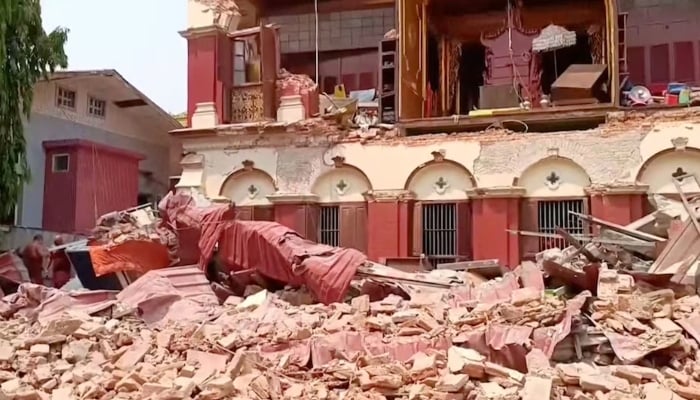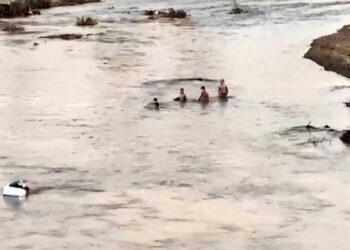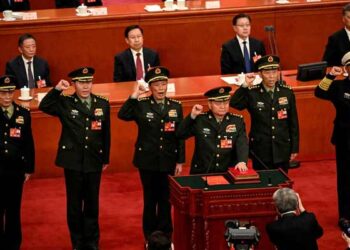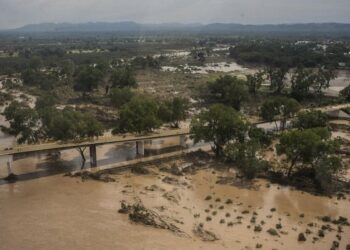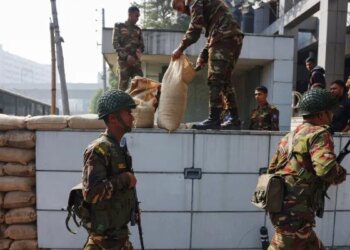Select Language:
In the aftermath of a powerful earthquake that devastated buildings in Mandalay, Myanmar, on Friday, survivors frantically searched through the rubble with their hands, desperately trying to rescue those who remained trapped.
Local residents and rescuers in Myanmar’s second-largest city reported to Reuters that, without heavy machinery or government assistance, they faced significant challenges in reaching the survivors who were calling for help.
Htet Min Oo, 25, miraculously escaped when a brick wall fell on him, leaving him partially buried. He lamented that his grandmother and two uncles were still trapped beneath the debris of a building, which he desperately tried to clear with his hands.
“There’s just too much debris, and no rescue teams have arrived yet,” he said, tears streaming down his face.
Myanmar has faced turmoil since a military coup in 2021 removed an elected government, leading to brutal crackdowns on protests and igniting a widespread armed resistance.
According to humanitarian organizations, the earthquake, which registered a magnitude of 7.7 and claimed over 1,000 lives, struck at an especially vulnerable time for the nation, following four years of military rule and civil conflict that have devastated infrastructure and displaced millions.
“The recent earthquake struck at the worst possible time for Myanmar,” stated Sheela Matthew, deputy country director for the World Food Program. “The nation cannot withstand another disaster.”
Amid “widespread violence,” the country’s healthcare system has been severely damaged by conflict and overwhelmed by outbreaks of cholera and other diseases, noted Mohammed Riyas, country director for the International Rescue Committee.
He added, “The added burden of addressing the needs of those injured in the earthquake is going to put immense pressure on already strained resources.”
Requests for comment from Myanmar’s military junta went unanswered.
The foreign minister of the National Unity Government, a parallel civilian authority representing pro-democracy factions, informed Reuters that anti-junta forces would be deployed to aid in disaster relief.
Polycrisis
In January, the United Nations described Myanmar as facing a “polycrisis” characterized by economic collapse, escalating conflict, climate emergencies, and increasing poverty. Over half of the population lives without electricity, and many hospitals in conflict zones are non-functional.
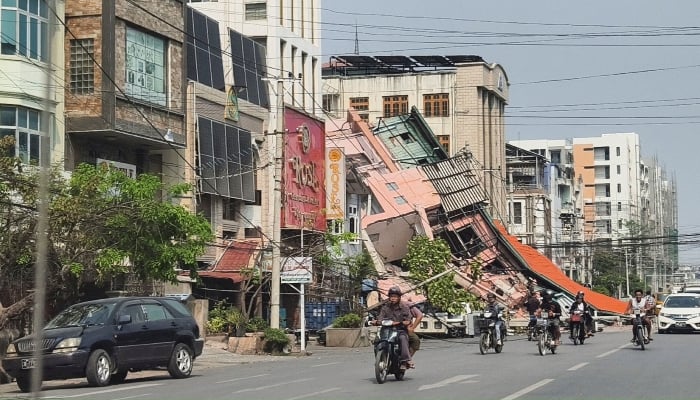
More than 3.5 million individuals have been internally displaced, with many fleeing across borders due to ongoing clashes between the military and various armed groups taking control of large areas.
On Friday, military planes were reported to have carried out airstrikes and drone assaults shortly after the earthquake in Karen state, near the stronghold of one of the largest ethnic armed groups, according to Free Burma Rangers, a humanitarian organization.
Nyi Nyi Kyaw, an academic from Myanmar currently at Bristol University, commented on social media that the loss of a “significant proportion of the youth, especially young men, to forced military conscription” would severely limit the disaster response efforts.
“Cities and towns are deserted by young men who once would have mobilized for rescue and relief,” he noted.
He continued, “There is no properly functioning—let alone legitimate—government in the regions most affected by the earthquake.”
A rescue worker attempting to liberate 140 monks trapped beneath the rubble of a collapsed building in Amarapura, Mandalay, expressed frustration, saying, “We cannot assist because we lack sufficient manpower and machinery to clear the debris.”
Nevertheless, he emphasized, “We will continue our efforts.”
No Assistance
The junta has made an unusual request for international aid, with disaster relief teams from Russia, China, Singapore, and India planning to arrive on Saturday.
However, human rights advocates have expressed concern that relief efforts may not reach those in need, given the regime’s history of obstructing aid to areas controlled by opposing forces.
Thomas Andrews, the UN’s special rapporteur for human rights in Myanmar, stated in a post on X that the military’s response to a recent cyclone and typhoon demonstrated its “willingness to exploit aid during natural disasters.”
In December, Reuters reported that the junta had intimidated aid organizations and stifled information about a severe food crisis by pressuring researchers to avoid collecting data on hunger.
Residents in Mandalay told Reuters that they had yet to see any assistance from military authorities.
One rescue worker noted they had borrowed equipment from local businesses to help search through the ruins, stating they had received no support from the military government, but refrained from providing further details out of fear of retaliation.
Some residents have taken to Facebook to request machinery for rescue efforts.
One user wrote that family members were trapped under the rubble of a mosque and urged, “We desperately want to recover their bodies.”
“We need to rent a crane to lift the heavy concrete blocks. If anyone knows where we can rent one, please let us know,” they pleaded.

